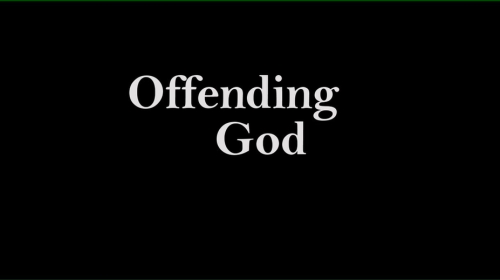
Context & Matthew 24
There is a persistent argument concerning Jesus’ Olivet Discourse in Matthew 24. Again, it concerns the old saw that “this generation” Jesus is referring to means that first century generation, and therefore we can take all of Jesus’ discussion about great tribulation, etc., put a nice little bow on it and consider that entire chapter’s prophecies signed, sealed and delivered. There have been a few excellent articles, blogs and sermons preached from the Greek, how we ought to understand the meaning.

So, context. One brother insisted that we should understand the context of Matthew 24 as well based upon the context of Matthew 23, and that the one gives us the context for the other. But does it? In a way it does, if one wishes to say the context is Jerusalem because both chapters are very much about Jerusalem. Indeed, most of the Bible is about that setting and, as a capstone sermon at the end of Christ’s ministry, it is fitting this sermon should take place in Jerusalem. Also, chapters 23 and 24 do take place on the same day, so there is that. Similarities are often easily noted but to be honest with any comparisons, we must also note the differences for they too can be significant.
So, Matthew 23, Jesus begins in the temple, speaking to Jews. Not just any Jews, for the same bunch plotting his death are here as well as Jesus’ disciples. Luke 21 is this setting, btw. Luke 21 is very much about that era, that temple and the more immediate trouble soon to beset Jerusalem. However, there is an important distinction between what dominates Luke’s record of this day and Matthew’s. Meantime, Mark in chapter 13 also follows the Matthew 24 setting, but only, as it were, in passing. What is that difference to which I refer? Quite simply, there is indicated, clearly, a transition. The entire scene shifts from the temple, to up on the mount. The audience is even left behind and Mark 13 tells us only four of Jesus’ inner circle even hear the entirety of Matthew’s account (that continues into chapter 25, by the way).
Then Jesus went out and departed from the temple, and His disciples came up to show Him the buildings of the temple.
Now context, once again. The location changed and the audience changed. How about the subject matter? Does that change? Jesus just spent several verses castigating the religious elite for their profound hypocrisy. He leaves and walks up the hill, four of his disciples following him up. They are discussing the temple still and Jesus does remark on that particular temple and its demise. Jesus takes a seat on the ground (v. 3) as these disciples no doubt marvel at Jesus’ words that the temple would be destroyed, not one stone left upon another. They are naturally curious, so they ask him about it. But their line of questioning is ignorant in that they have never been told about these events and how they knit together with the words of the prophets.
We see here and again later that the disciples mistakenly think Jesus is about to “make his move” and wrest rule from the Romans and take the throne. This happens again a bit later even as Jesus tries to make them understand that they are not prepared for the eternal kingdom and that he himself must lay down his life before they can ever see it. There is also, no doubt, a heavy dose of denial among the disciples as well. It is all very understandable as they, once again, find themselves enslaved to yet another nation. So, the net result is they ask Jesus what they think is a simple question or two, not realizing the answers are more complex than they realize.

The disciples ask concerning the destruction of the temple (which was 70 A.D., eventually), and mix that in with the sign of Jesus’ coming, and of the end of the age. So that line of questioning is clearly a hot mess, as the saying goes. What does Jesus then do? He proceeds (as the graphic shows) to answer their line of questioning in the order they asked.
I have not forgotten. We are trying to determine context and what, if anything, the remainder of the chapter has to do with the former chapter. The answer is, not much. “When will these things be” is indeed asked on the heels of a big talk back at the temple and Jesus’ remark that it’s going to come down. He discusses circumstances around this event all the way up into about verse 11-12. I say “about” because there is much overlap, historically. History does repeat itself. Imagine the stunned and crestfallen looks on their faces by the time Jesus reaches this point. Go on and read it.
Are you back? Horrific, isn’t it? And a few decades later, all these things did happen. Jesus seems to see the need to drop a word of encouragement in verses 13 and 14, verse 14 closing out the first part of the question with “and then the end will come.”
The second part is about what will be the sign of Christ’s coming, so he runs that down beginning in verse 15. Biblical prophecy is about pattern… near and far prediction. As an example, yes, Daniel predicted the Abomination of Desolation. Hundreds of years later was a Near fulfillment in the person of Anticochus Epiphanes. Correct? And yet, Jesus, two hundred years after Antiochus, speaks of the future and says, “when you see the abomination that makes desolate as spoken of by the prophet Daniel…” How can this be if it is prediction/fulfillment, one time and that’s it?
Therefore, we MUST conclude that indeed, there are Near and Far (final) predictions. Or, did Jesus get it wrong? Therefore, to conclude that the sacking of Jerusalem could be ONLY in 70 A.D. and therefore must be taken off the table is presumption. ESPECIALLY in light of the fact that Jesus himself said there will be no time BEFORE it or AFTER that is worse, again, unless we wish to say Jesus was in error and did not see both World Wars coming.
Was their “great tribulation” in 70 A.D.? No doubt! Were those days shortened? Well, we are still here. This indicates to us, or should to any thinking person. Yes, there are similarities and the disciples did not realize there would be a third temple later and another repeat of history, but THOSE days were not shortened, were they. And yet flesh was saved. This is clearly yet future.
To clarify for us that Jesus is addressing the future events and not merely the 70 A.D. events, he offers us verses 29-31. What DOES Jesus say will happen “IMMEDIATELY after the great tribulation of those days”? Allow me to put the verses in simple list form:
“IMMEDIATELY after the tribulation of those days
1) the sun will be darkened, andn2) the moon will not give its light;n3) the stars will fall from heaven, andn4) the powers of the heavens will be shaken. 30 Thenn5) the sign of the Son of Man will appear in heaven, and thenn6) all the tribes of the earth will mourn, andn7) they will SEE THE SON OF MAN COMING on the clouds of heaven with power and great glory. 31 Andn8) He will send His angels with a great sound of a trumpet, andn9) they will gather together His elect from the four winds, from one end of heaven to the other.”
So we can wrangle and wrest the “sign” in item 5 all we want, but that does not dismiss the rest, including item 7, actually SEEING the Son of Man coming on the clouds, etc.
Therefore, again with respect to Context, can we honestly still draw this list and the context back into 70 A.D., even with all the alleged chapter 23 context? Frankly, even with my writer’s imagination, I really cannot imagine a way to bring all the items in this list into any time at all in the past, even through spiritualizing or allegorizing the text.
To demonstrate how futuristic Jesus was in explaining the bulk of chapter 24, he says “the end” and talks about his coming like THIRTEEN TIMES here, so it cannot be about anything else. As indicated, how does it work if “21 For then there will be great tribulation, such as has not been since the beginning of the world until this time, no, nor ever shall be,” is about 70 A.D.? So the lead up to “great tribulation” has never been so bad, and if that is 70 A.D., how does that square with either World War SINCE that time? Look at Matthew 24:
Verse 13 refers to “the end.”
Verse 14, “the end.”
Verse 22 says “those days will be shortened” (not go on for another 2,000 years).
Verse 27 “the coming of the Son of Man.”
Verse 30 “the Son of Man coming”
Verse 31 “angels…will gather together His elect…” (which clearly has not happened yet).
Verse 33 “…see these things…it is near”
Verse 37 “the coming of the Son of Man.”
Verse 39 “the coming of the Son of Man.”
Verse 42 “your Lord is coming.”
Verse 44 “The Son of Man is coming”
Verse 46 “his master, when he comes”
Verse 50 “the master… will come on a day”
See the pattern? These are future end times things, not 70 A.D. things. Then there is chapter 25…









